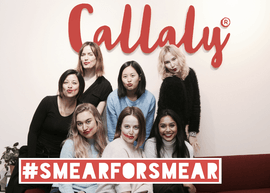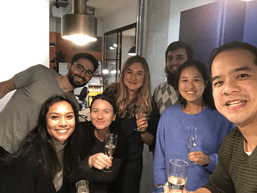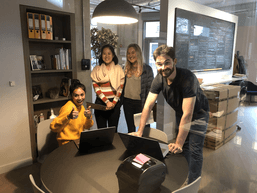Spending IAP Behind the Scenes of a Feminine-Care Startup
-
-
Slice of MIT
Filed Under
Recommended

Each January during Indendent Activities Period (IAP), hundreds of students work alongside alumni sponsors as part of the Student/Alumni Externship Program. This year Leandra Zimmerman ’19 (Course 2A with a minor in Course 6) and Nancy Hung ’19 (Course 6-3) were externs for Callaly, a feminine-care startup, working with Vinh-Thang Vo-Ta ‘98. Below, they share their firsthand experiences.
Would you like to sponsor an extern next January? The program accepts online submissions of new opportunities each summer.
Leandra
I came to Callaly as a manufacturing intern at an exciting time. Its new product, the Tampliner (a tampon/liner combination) is moving from manual stations into semiautomatic production.
Here’s what I learned as a manufacturing intern at Callaly.
The long process behind developing a consumer health product
It was fascinating for me to see the development process of the Tampliner, from initial prototypes to the current version, which is made on multiple manual stations. Soon, a semiautomatic machine will enable faster production and make the product accessible to more women around the world.
In my role, I came up with potential design improvements to the current product. Additionally, I enjoyed doing research into specialized medical applications and generating concepts and ideas about how to change the current design for potential new markets.
New insights into the relationship with manufacturers
I was very fortunate that I could join team visits to Callaly’s machine builders and contract manufacturers. I learned how important it is to find the right partners with high quality standards, expertise, and commitment.
The importance of rigorous quality control
I was able to apply my engineering knowledge by working on a coherent and controlled set of technical drawings and on test procedures for quality control of the product. Other fun tasks included running durability tests to gain insight into the product, possible weaknesses, and areas to improve. It opened my eyes to how important rigorous control processes are, especially in the femcare market where failures can lead to danger for the user.
I especially enjoyed the collaborative and encouraging atmosphere at Callaly. My coworkers were motivated and welcoming. I got a ton of life advice from Callaly’s CEO, Vinh-Thang Vo-Ta ’98, my supervisor, and my inspiring coworkers.
My biggest takeaway is that a good idea is not enough—it really is the team and the attention to feedback and improvement put into innovative development that matters.
Nancy
As a user experience (UX) intern, I worked with the customer experience and online platform leads on Callaly’s new product launches. There were three myths I held before the externship that my experiences with the company dispelled.
Myth 1: I can’t get much out of four weeks of work experience.
Although the first few days were spent getting familiar with the product, my new teammates, and current projects, within the first week I completed a summary of user flows for competitors’ online experiences. By the second week, I helped lead a product demo meeting, added a new project, and compiled mockup and prototyping design resources and started wireframing. In week three, I created a product requirements document (PRD) template for the team to continue using past my externship and outlined the product pipeline from conception to deployment. At the end of week four, I finished wireframes for a project and wrapped up my projects for handoff.
The secret of this productivity: asking and trying. I spent time during my first week asking questions to understand my co-workers’ workflows and identify gaps where I could deliver the most value.
Myth 2: I’m not useful because I’m still a student.
My job description was loosely defined—my work was a mix of product design, product management, and supporting the team infrastructure. I did not have professional experience like this before, but my mentors did not expect me to be an expert—they encouraged me to try and learn. In fact, everyone at the company continues to learn and grow no matter their work experience.
Myth 3: I’m not qualified to do the work I’m doing.
I had reservations about my comparative lack of work experience. However, while brainstorming with marketing and content teams, I was asked for my opinion, which gave me the confidence to speak up. MIT teaches us strong problem-solving skills combined with empathy for users, and I was still able to help in a field where I had no professional experience. I was treated as an equal in meetings and was fully integrated into the team, and it serves as a good reminder that MIT students should believe in our own capabilities.













